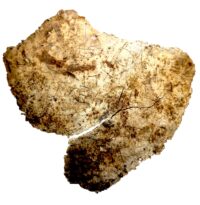 Archaeologists have discovered a unique Christian artifact at the Roman fort of Vindolanda just south of Hadrian’s Wall. It’s a fragmentary lead chalice etched with Christian symbols, the only chalice from this period ever found in Britain.
Archaeologists have discovered a unique Christian artifact at the Roman fort of Vindolanda just south of Hadrian’s Wall. It’s a fragmentary lead chalice etched with Christian symbols, the only chalice from this period ever found in Britain.
The remains of the chalice were discovered in the collapsed walls of a building identified as a 5th/6th century Christian church. It was found in 14 pieces, all in poor condition because it was close to the surface and not buried in the waterlogged anaerobic soil that has preserved thousands of leather shoes and the only Roman wooden toilet seat ever discovered.
Every fragment was densely inscribed with Christian symbols on both inner and outer surfaces. They seem to be random in arrangement and meaning, like doodles.
The marks appear to have been added, both to the outside and the inside of this cup, by the same hand or artist and although they are now difficult to see with the naked eye, with the aid of specialist photography, the symbols have been carefully recorded and work has started on a new journey of discovery to unlock their meanings. The etchings include some well-known symbols from the early church including ships, crosses and chi-rho, fish, a whale, a happy bishop, angels, members of a congregation, letters in Latin, Greek and potentially Ogam.
The academic analysis of the artefact is ongoing with the post-Roman specialist Dr David Petts from Durham University taking the lead on the research and commented: “This is a really exciting find from a poorly understood period in the history of Britain. Its apparent connections with the early Christian church are incredibly important, and this curious vessel is unique in a British context. It is clear that further work on this discovery will tell us much about the development of early Christianity in beginning of the medieval period.”
The chalice fragments are featured in a new exhibition dedicated to Vindolanda’s Christian history. The show opens on Monday, August 31st.
A happy bishop? How could anyone determine that such etchings are a bishop much less a happy one?
There is one that appears to be smiling and holding a crozier.
Drinking from a lead chalice seems a bit detrimental to one’s health. :skull:
Where is the exhibition being held?
What’s so surprising about finding a religious artefact in the walls of a church?
…Chalice? The Holy Hand Grenade of Antioch! :yes:
Instructions from the Book of Armaments, Ch 2, verses 9–21:
—————-
“First shalt thou take out the Holy Pin. Then shalt thou count to three, no more, no less. Three shall be the number thou shalt count. Four shalt thou not count, neither count thou two, excepting that thou then proceed to three. Five is right out. Once the number three, being the third number, be reached, then lobest thou thy Holy Hand Grenade of Antioch towards thy foe, who, being naughty in My sight, shall snuff it.”
—————-
Arthur, King of the Britons: —“One! Two! Five!”
To rearrange some of the comments:
Comment by MA Hoffman
How could anyone determine that such etchings are a bishop much less a happy one?
Comment by Dr. E
Drinking from a lead chalice seems a bit detrimental to one’s health.
Comment by Patrick
There is one that appears to be smiling and holding a crozier.
What distinguishes the building as a church?
James, it is usually the location, orientation, the existence of the church features such as an altar base, and, often, burials inside and outside the walls. There is no shortage of former church/chapel sites for archaeologists to dig in Britain, and there is a lot of historical data as well, such as the writings of the Venerable Bede.
There is a similar age chapel still standing in Essex, on the site of the former gateway into a Roman fort, reusing Roman brick: https://en.wikipedia.org/wiki/Chapel_of_St_Peter-on-the-Wall